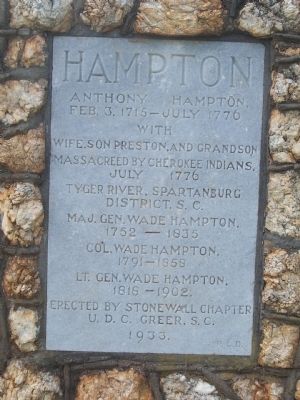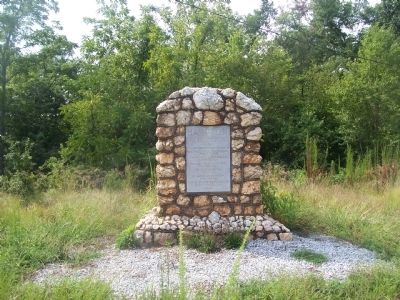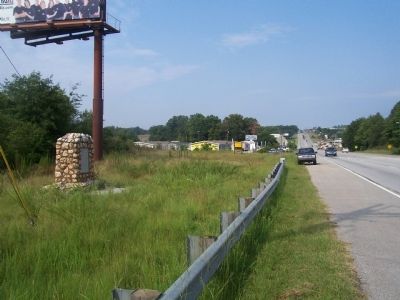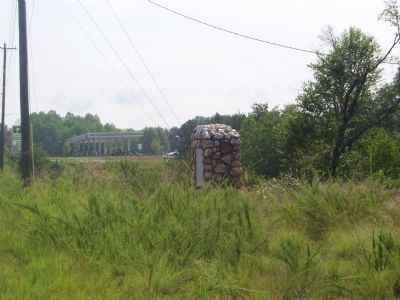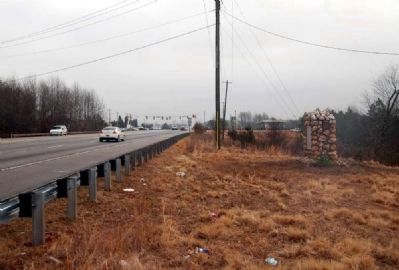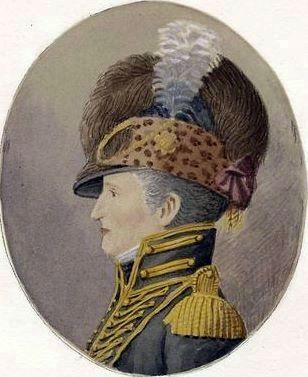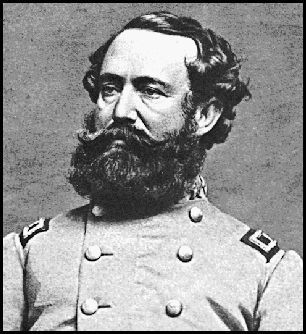Greer in Spartanburg County, South Carolina — The American South (South Atlantic)
Hampton
Feb. 3, 1715 - July 1776
with
wife, son Preston, and grandson
massacreed by Cherokee Indians,
July 1776
Tyger River, Spartanburg
District, S. C.
Maj. Gen. Wade Hampton
1752 - 1835
Col. Wade Hampton,
1791 - 1858
Lt. Gen Wade Hampton,
1818 - 1902
Erected 1933 by Stonewall Chapter, United Daughters of the Confederacy, Greer, S.C.
Topics and series. This historical marker is listed in these topic lists: Colonial Era • Native Americans • Notable Events • War, US Revolutionary. In addition, it is included in the United Daughters of the Confederacy series list. A significant historical month for this entry is July 1776.
Location. 34° 57.12′ N, 82° 10.936′ W. Marker is in Greer, South Carolina, in Spartanburg County. Marker is on E Wade Hampton Boulevard (U.S. 29) 0.1 miles south of J. Verne Smith Parkway, on the right when traveling north. Touch for map. Marker is in this post office area: Greer SC 29651, United States of America. Touch for directions.
Other nearby markers. At least 10 other markers are within 3 miles of this marker, measured as the crow flies. Woods Fort (approx. 1.7 miles away); Indian Boundary Line (approx. 2.2 miles away); a different marker also named Indian Boundary Line (approx. 2½ miles away); National Highway (approx. 2.6 miles away); AH-1 Cobra Helicopter (approx. 2.6 miles away); All Wars Memorial (approx. 2.6 miles away); Greer Area Veterans Memorial (approx. 2.6 miles away); Ronnie Eugene Norris Remembrance Fountain (approx. 2.7 miles away); M106A1 Mortar Carrier (approx. 2.7 miles away); 101 Trade Street (approx. 2.7 miles away). Touch for a list and map of all markers in Greer.
More about this marker. The location of the marker, Wade Hampton Boulevard, is named for General Wade Hampton, C.S.A., great-grandson of Anthony Hampton.
Also see . . .
1. Wade Hampton I. Wade Hampton (1752 – February 4, 1835) was a South Carolina soldier, politician, two-term U.S. Congressman, and wealthy plantation owner. (Submitted on February 26, 2011, by Brian Scott of Anderson, South Carolina.)
2. Wade Hampton I - Find-a-Grave Memorial. Lieutenant colonel, Revolutionary War. (Submitted on February 26, 2011, by Brian Scott of Anderson, South Carolina.)
3. Wade Hampton II. Wade Hampton II (April 21, 1791 – February 10, 1858) was an American plantation owner and soldier in the War of 1812. (Submitted on February 26, 2011, by Brian Scott of Anderson, South Carolina.)
4. Wade Hampton II - Find-a-Grave Memorial. Trinity Episcopal Cathedral Cemetery, Columbia, Richland County, South Carolina, USA. (Submitted on February 26, 2011, by Brian Scott of Anderson, South Carolina.)
5. Wade Hampton III. Wade Hampton III (March 28, 1818 – April 11, 1902) was a Confederate cavalry leader during the American Civil War and afterward a politician from South Carolina, serving as its 77th Governor and as a U.S. Senator. (Submitted on February 26, 2011, by Brian Scott of Anderson, South Carolina.)
6. Wade Hampton III - Find-a-Grave Memorial. Civil War Confederate Lieutenant General, South Carolina Governor, US Senator. (Submitted on February 26, 2011, by Brian Scott of Anderson, South Carolina.)
Additional commentary.
1. Hampton Indian Massacre
When the Indians appeared at the Hampton house, Preston saw a friendly chief in the part and went outside to greet him. His father followed him into the yard. Old Mr. Hampton gave the Chief a cordial welcome and handclasp, but almost immediately Preston was shot down by a Tory, and the hand Anthony had held sent a tomahawk through his skull. Mrs. Hampton appeared and was killed in like manner. The Indians entered the house, drank some brandy, and pillaged the family wardrobes.
Hearing the war whoops, Elizabeth Harrison and Mrs. Sadler crept across the canebrake to investigate, Coming in sight of the house, they saw the mutilated bodies of Mr. and Mrs. Hampton and Preston in the yard. As the terrified women watched, a Cherokee brave carried Elizabeth's infant into the yard and holding him by the feet, dashed his brains out against a tree. Mrs. Sadler clasped her hand over Elizabeth's mouth to stifle her scream and pulled her back through the canebrake to a place where their horses were tethered. Mounting bareback, they galloped to Wood's Fort for help.
A search party was sent out, but by the time they reached the Hampton place the Indians had burned the house and departed, taking Preston's wagons and the Hamptons' nine year old grandson, John Bynum, with them. The marauders had disappeared over the mountains into Cherokee country. It is said that the raiding party stopped at Preston's home some distance away and murdered his two children. His wife fled through the swamp and was found several days later wandering through the woods, her clothing torn to rags. She was so frightened that her mind never fully recovered from the ordeal.
Another band of Cherokees galloped north and before their raids were over had murdered members of the Hannon family in the vicinity of Earle's Fort.
The Hite, Hampton, and Hannon massacres meant war with the Indians. Col. Andrew Williamson, who headed the 96th Whig militia, and Anthony's old friend, Col Griffith Rutherford of NC, led their troops over the mountains into the Cherokee Nation. Joining Williamson were all five of the Hampton sons, John, Edward, Henry, Wade, and Richard. In a series of bloody conflicts, they defeated the Indians and burned all their villages and crops in the valleys. The Cherokees sued for peace and in the Treaty of 1777 returned all captives, including John Bynum. They also ceded to S.C. the territory of present Greenville, Pickens, and Oconee counties. (Source: Colonial and Revolutionary History of Upper South Carolina, eyewitness account of John Mynum as related to J.B.O. Landrum.)
— Submitted March 1, 2009, by Brian Scott of Anderson, South Carolina.
2. Wade Hampton I (1752-1835)
Wade, (grandfather of Wade Hampton [1818-1902]), a Representative from South Carolina; born in Virginia in 1752; received a thorough education; engaged in agricultural pursuits; moved to South Carolina; served in the Revolutionary War as lieutenant colonel of the regiment of light dragoons in General Sumter’s brigade of State troops; served in the
state assembly, 1779-1786 and 1791; elected as a Republican to the Fourth Congress (March 4, 1795-March 3, 1797); unsuccessful candidate for reelection; elected to the Eighth Congress (March 4, 1803-March 3, 1805); unsuccessful candidate for reelection; colonel in the United States Army in 1808; appointed brigadier general in February 1809 and major general March 2, 1813; served in the War of 1812 until April 6, 1814, when he resigned; died in Columbia, S.C., on February 4, 1835; interment in Trinity Churchyard, Columbia, S.C. (Source: Biographical Directory of the United States Congress.)
— Submitted February 26, 2011, by Brian Scott of Anderson, South Carolina.
3. Wade Hampton III (1818-1902)
Wade Hampton, (grandson of Wade Hampton [1752-1835]), a Senator from South Carolina; born in Charleston, S.C., March 28, 1818; received private instruction, graduated from the South Carolina College (now the University of South Carolina) at Columbia in 1836; studied law but never practiced; planter; member, State house of representatives 1852-1856; member, State senate 1858-1861; served in the Confederate Army during the Civil War, raising and commanding “Hampton’s Legion”; three times wounded; made brigadier general in 1862, major general in 1863, and lieutenant general in
1865; Governor of South Carolina 1876-1879; elected in 1878 as a Democrat to the United States Senate; reelected in 1884 and served from March 4, 1879, until March 3, 1891; unsuccessful candidate for reelection; United States railroad commissioner 1893-1897; died in Columbia, S.C., April 11, 1902; interment in Trinity Cathedral Churchyard. (Source: Biographical Directory of the United States Congress.)
— Submitted February 26, 2011, by Brian Scott of Anderson, South Carolina.
Credits. This page was last revised on April 6, 2022. It was originally submitted on August 18, 2008, by M. L. 'Mitch' Gambrell of Taylors, South Carolina. This page has been viewed 3,717 times since then and 141 times this year. Photos: 1, 2, 3, 4. submitted on August 18, 2008, by M. L. 'Mitch' Gambrell of Taylors, South Carolina. 5, 6, 7. submitted on February 26, 2011, by Brian Scott of Anderson, South Carolina. • Kevin W. was the editor who published this page.
